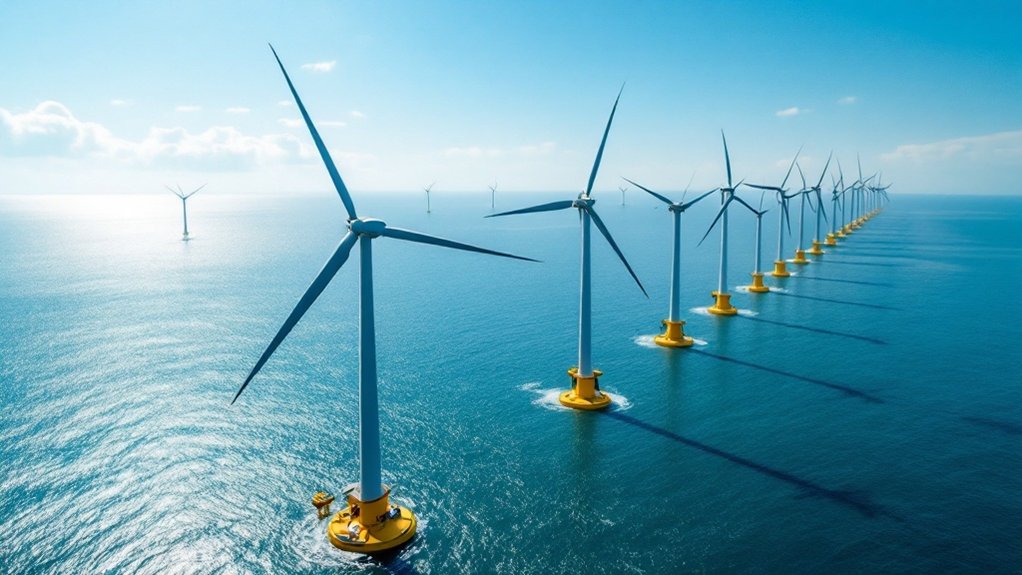
Innovations Revolutionizing Offshore Wind Farm Efficiency
The landscape of offshore wind energy is undergoing significant transformation. Innovations in turbine design, predictive maintenance, and floating wind technology are reshaping efficiency and output. These advancements not only promise enhanced performance but also aim to address environmental concerns. As the industry navigates these changes, the implications for energy generation and sustainability remain to be fully explored. What are the potential challenges and benefits that lie ahead?
Advanced Turbine Designs Enhancing Energy Capture
Recent advancements in turbine designs have greatly enhanced energy capture in offshore wind farms. Innovative rotor configurations, such as larger diameters and increased blade lengths, allow these turbines to harness more wind energy at lower wind speeds. Additionally, the integration of variable pitch blades enables turbines to adjust their angle according to wind conditions, optimizing performance and efficiency. Enhanced control systems now monitor real-time wind data, allowing for immediate adjustments to maximize energy output. Moreover, improved drivetrain technologies reduce energy losses, translating to higher overall efficiency. These advancements not only increase the amount of energy generated but also contribute to the economic viability of offshore wind projects, positioning them as a critical component of renewable energy strategies worldwide. As the renewable energy sector continues to grow, innovations like these will be essential in achieving a sustainable future.
Cutting-Edge Materials for Durability and Performance
The advancements in turbine designs have paved the way for innovations in materials that enhance the durability and performance of offshore wind farms. Researchers have developed advanced composites and coatings that resist corrosion and fatigue, essential factors in harsh maritime environments. These materials, such as carbon fiber and specialized polymers, greatly reduce weight while maintaining strength, allowing for larger, more efficient turbines. In addition, innovations like self-healing materials can extend the lifespan of components by automatically repairing minor damages. The integration of these cutting-edge materials not only improves operational efficiency but also minimizes maintenance costs and enhances overall reliability. As the industry evolves, the continuous refinement of these materials will play a crucial role in the future success of offshore wind energy. Furthermore, sustainable practices are increasingly being integrated into wind energy development to ensure long-term viability and environmental protection.
AI-Driven Predictive Maintenance Systems
As offshore wind farms continue to expand, the implementation of AI-driven predictive maintenance systems emerges as a transformative solution to enhance operational efficiency. These systems utilize advanced algorithms and machine learning to analyze data collected from various sensors installed on wind turbines. By predicting potential failures before they occur, operators can schedule maintenance activities more effectively, thereby minimizing downtime and reducing repair costs. The integration of AI allows for real-time monitoring and assessment of turbine health, enabling swift decision-making. Additionally, this technology can optimize energy production by ensuring that turbines operate at peak performance. As a result, AI-driven predictive maintenance not only improves reliability but also contributes considerably to the overall sustainability of offshore wind energy operations. Furthermore, this approach aligns with the trend of AI optimizing healthcare operations, illustrating the broader impact of AI technology across various industries.
Floating Wind Farms: Expanding Possibilities
Floating wind farms offer significant advantages, such as access to deeper waters where wind resources are typically stronger and more consistent. However, the deployment of these innovative structures presents unique challenges, including technical complexities and higher costs. Addressing these issues is essential for unblocking the full potential of floating wind technology. Additionally, embracing minimalism in design can help streamline construction processes and reduce costs, ultimately enhancing the efficiency of offshore wind farms.
Advantages of Floating Designs
Innovative floating wind farms are revolutionizing the renewable energy landscape by unfastening new possibilities for harnessing wind power in deeper waters. One significant advantage of these designs is their ability to be deployed in locations previously inaccessible to traditional fixed-bottom turbines, allowing for greater energy generation potential. Additionally, floating structures can capitalize on stronger, more consistent winds found offshore, enhancing overall efficiency. The modular nature of floating designs facilitates easier transportation and installation, reducing logistical challenges. Moreover, these systems have a lower environmental impact on marine ecosystems, as they avoid disrupting the seabed. Ultimately, floating wind farms represent a promising advancement in renewable energy technology, expanding the scope of offshore wind energy production while promoting sustainability.
Challenges in Deployment
While floating wind farms present exciting opportunities for renewable energy generation, several challenges must be addressed to guarantee successful deployment. Key issues include high construction and maintenance costs, which can deter investment and slow development. Additionally, the technological complexity of floating platforms requires specialized knowledge and skills, limiting the workforce available for projects. Environmental concerns, such as potential impacts on marine ecosystems and navigation routes, also necessitate thorough assessments and regulatory compliance. Moreover, the integration of floating wind energy into existing power grids poses technical challenges, particularly regarding stability and reliability. Addressing these challenges through innovation and collaboration among industry stakeholders is essential for realizing the full potential of floating wind farms in the renewable energy landscape.
Energy Storage Solutions for Stability and Reliability
As offshore wind farms continue to expand, the need for effective energy storage solutions becomes increasingly critical to guarantee stability and reliability in energy supply. Energy storage technologies, such as batteries and pumped hydro storage, are essential in addressing the intermittent nature of wind energy generation. These solutions allow excess energy produced during peak wind conditions to be stored and released during low production periods, ensuring a consistent power supply. Additionally, advancements in lithium-ion and flow battery technologies are enhancing storage capacity and efficiency. The integration of energy storage systems not only improves grid stability but also enables better management of demand fluctuations, ultimately contributing to the overall resilience of offshore wind energy infrastructure. Moreover, achieving work-life balance is vital for those working in the renewable energy sector to maintain productivity and well-being.
Innovative Grid Integration Technologies
Effective integration of offshore wind energy into existing power grids relies on advanced technologies that enhance connectivity and facilitate energy distribution. One key innovation is the development of high-voltage direct current (HVDC) systems, which allow for efficient transmission of electricity over long distances with minimal losses. These systems can connect multiple wind farms to the grid, optimizing energy flow. Additionally, smart grid technologies enable real-time monitoring and management of energy supply and demand, improving grid resilience and reliability. The use of advanced forecasting tools enhances the predictability of wind energy generation, aiding grid operators in balancing supply. Moreover, energy management systems are increasingly incorporating artificial intelligence to optimize integration processes, ensuring maximum utilization of offshore wind resources while maintaining grid stability.
Environmental Monitoring and Impact Mitigation Strategies
Environmental monitoring and impact mitigation are critical components of offshore wind farm development. Utilizing real-time data collection allows for timely assessments of ecological changes, while biodiversity impact assessments help identify potential risks to marine life. In addition, advancements in mitigation technologies are essential for minimizing adverse effects on the environment during the operational phase of these renewable energy projects.
Real-time Data Collection
How can real-time data collection enhance the sustainability of offshore wind farms? By enabling continuous monitoring of environmental conditions, real-time data collection allows for proactive management of potential impacts on marine ecosystems. Sensors deployed across wind farms can track variables such as water temperature, salinity, and weather patterns, providing essential insights for operational decision-making. This data facilitates timely adjustments in turbine operation, minimizing disturbances to local wildlife and habitats. In addition, real-time monitoring supports compliance with regulatory requirements and enhances transparency, fostering trust among stakeholders. The integration of data analytics also aids in optimizing energy production by identifying patterns in wind behavior, ultimately leading to more efficient and sustainable offshore wind operations.
Biodiversity Impact Assessments
While offshore wind farms offer significant renewable energy potential, their development necessitates thorough biodiversity impact assessments to understand and mitigate potential effects on marine ecosystems. These assessments evaluate the potential risks to local species and habitats, ensuring that ecological considerations are integral to project planning. Stakeholders, including marine biologists and environmental organizations, collaborate to gather data on species distribution, migration patterns, and habitat health. The assessments focus on identifying essential habitats and potential disruptions caused by construction and operation. By addressing these concerns, developers can implement strategies that minimize ecological disturbance and promote marine biodiversity. Ultimately, detailed biodiversity impact assessments are essential for balancing renewable energy goals with the preservation of crucial marine ecosystems.
Mitigation Technology Advancements
Mitigation technology advancements play a significant role in addressing the potential ecological impacts identified during biodiversity impact assessments of offshore wind farms. Innovative strategies such as real-time environmental monitoring systems are being developed to track marine life and mitigate adverse effects. These systems utilize sensors and AI algorithms to detect changes in wildlife behavior, allowing for timely interventions. Additionally, advancements in turbine design aim to reduce noise and visual pollution, further minimizing impact on marine ecosystems. Habitat restoration techniques, including artificial reefs, are also being implemented to enhance biodiversity around wind farms. Collectively, these technologies not only improve operational efficiency but also contribute to sustainable development by ensuring that ecological integrity is maintained throughout the lifecycle of offshore wind projects.
Frequently Asked Questions
How Do Offshore Wind Farms Impact Local Wildlife and Ecosystems?
The impact of offshore wind farms on local wildlife and ecosystems is complex. They can disrupt habitats, alter migration patterns, and affect marine life, yet they also promote sustainable energy and potentially mitigate climate change effects.
What Are the Costs Associated With Building Offshore Wind Farms?
The costs associated with building offshore wind farms include infrastructure development, equipment procurement, installation, maintenance, and regulatory compliance. These expenses can vary greatly based on location, technology, and scale of the project.
How Do Weather Conditions Affect Offshore Wind Farm Operations?
Weather conditions considerably influence offshore wind farm operations. High winds can enhance energy production, while storms pose risks to equipment and safety. Additionally, fog and extreme temperatures may hinder maintenance and operational efficiency, affecting overall performance.
What Is the Lifespan of an Offshore Wind Turbine?
The lifespan of an offshore wind turbine typically ranges from 20 to 25 years. Factors such as maintenance, environmental conditions, and technological advancements can influence this duration, potentially extending or shortening operational effectiveness over time.
Are There Regulatory Challenges for Offshore Wind Farm Development?
Regulatory challenges for offshore wind farm development encompass complex permitting processes, environmental assessments, and compliance with local and international regulations. These hurdles can delay projects and increase costs, impacting the overall viability and timeline of development initiatives.
Conclusion
The advancements in offshore wind farm technologies are transforming the renewable energy landscape, markedly enhancing efficiency and sustainability. With innovations in turbine design, predictive maintenance, and floating farm capabilities, these developments promise to optimize energy capture and reduce operational costs. In addition, energy storage and grid integration solutions, alongside environmental monitoring efforts, guarantee that offshore wind farms can operate reliably while minimizing ecological impacts. Collectively, these innovations pave the way for a more sustainable energy future.



